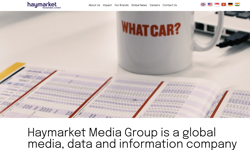Like something out of Star Trek, science fiction had become reality in one American magazine.
Entertainment Weekly readers last fall not only read about the new CBS shows, they also watched videos of those shows... in the print edition!
As part of an innovative marketing strategy driven by CBS and Pepsi, subscribers in New York and Los Angeles watched previews introduced by the stars of their favourite shows. The magazine succeeded in adding motion and sound to the visual aspect of the magazine experience, and, in doing so, became a “hybrid” magazine.
The September 18 issue of Entertainment Weekly had Anna Torv and Joshua Jackson from the TV series Fringe on the cover proudly announcing they had the “buzz on 85 TV shows”.
Developed in partnership with Americhip, the magazine contained the first ever “video in print” editorial / advertising spread, which played previews of CBS’ fall line-up and included product placement for Pepsi Max.
Americhip is a technology company that believes in “multisensorizing” a brand, communicating to a reader’s five senses. This fusion of media was achieved by inserting a thin monitor (2.7 millimetres thick), a speaker, and a lithium battery directly into the pages of the magazine.
Similar to the technology that is employed in greeting cards that “sing” over and over again when opened, the Entertainment Weekly / Americhip presentation could play continuously for an hour but, unlike the greeting card audio battery, the Entertainment Weekly battery could be recharged or even reprogrammed using a computer USB port. This product took the company two years to develop.
Brand futurist Martin Lindstrom, author of “Brand Sense,” has nothing but praise for what Americhip has achieved with its product.
“A brand is more than a name. It is an opportunity to create a sensory journey,” wrote Lindstrom recently. “Americhip is among the few to create brand journeys that captivate all our senses.”
CBS, which paid an undisclosed amount for the technology, sees the format as the next step in the promotion of their own brand.
“It is leadership in innovation, which we really stress at CBS in every part of our company,” CEO George Schweitzer said of the ads in Entertainment Weekly, “The evolution of marketing television in the fall used to be as simple as this,” Schweitzer said, holding up a vintage copy of TV Guide. “It was axiomatic in those days. If you took an ad in TV Guide, people watched your program. Not anymore.”
While the technology is impressive, it raises some questions about the practical application of this type of marketing.
“Fun, but futile” was the reaction of Michael Davies, a Senior Lecturer at the MIT Sloan School of Management writing in the Harvard Business Review. “What’s the point? One hopes the stunt is justified by the media buzz naming the companies involved as it breathlessly proclaims the birth of the video magazine, because little will justify it otherwise. While a remarkable technological achievement by Americhip, morphing the physical form from print to video misses the point of why print-based publications are so challenged. It does nothing to facilitate feedback, which is what advertisers want, or to give consumers the control over content they are coming to expect.”
Undeterred, EW editors say they are even now looking at new and exciting innovations to keep the magazine experience vital and fun for their readers.










